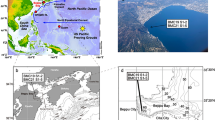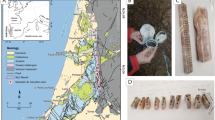Abstract
Conodonts are microfossils which are commonly found in marine rocks of Cambrian to Triassic age. Although their biological affinities are difficult to assess, conodonts are valuable stratigraphical indices for much of their geological range1. Recent work has also established that conodont colour alteration indices (CAI) are useful guides to diagenetic temperatures and hence burial depth2. Fission tracks3 in conodonts allow measurement of uranium concentrations and estimates of ‘age’ to be made using isotopic methods4. We report here that fission tracks counted in irradiated, thermally unaltered (as indicated by CAI) middle Palaeozoic conodonts indicate typical uranium concentrations of ∼1 part in 109, with some samples higher. A single specimen of Siphonodella from the Lower Mississippian yielded an age estimate of 380±140 Myr consistent with conventional interpolations. This method may also allow the unroofing of deeply buried sediments to be dated.
This is a preview of subscription content, access via your institution
Access options
Subscribe to this journal
Receive 51 print issues and online access
$199.00 per year
only $3.90 per issue
Buy this article
- Purchase on Springer Link
- Instant access to full article PDF
Prices may be subject to local taxes which are calculated during checkout
Similar content being viewed by others
References
Lindstrom, M. Conodonts (Elsevier, Amsterdam, 1964).
Epstein, A. G., Epstein, J. B. & Harris, L. D. U.S. Geol. Surv. Profess. Pap. 995 (1977).
Fleischer, R. L. & Price, R. B. Geochim. cosmochim. Acta 28, 1705–1714 (1964).
Fleischer, R. L., Price, R. B. & Walker, R. M. Nuclear Tracks in Solids—Principles and Applications (University of California Press, Berkeley, 1975).
Pietzner, H., Vahl, J., Werner, H. & Ziegler, W. Palaeontographica 128, 115–152 (1968).
Barnes, C. R., Sass, D. B. & Monroe, E. A. in Conodont Paleozoology (ed. Rhodes, F. H. T.) 1–30 (Geological Society of America, 1973).
Rhodes, F. H. T. Biol. Rev. Cambr. Phil. Soc. 29, 419–452 (1954).
Lindstrom, M. Conodonts, 30 (Elsevier, Amsterdam, 1964).
Mueller, K. J. & Nogami, Y. Mem. Fac. Sci. Kyoto Univ. Ser. Geol. Miner. 38, 1–87 (1971).
Carpenter, B. S. & Reimer, G. M. NBS Spec. Publ. 260–49 (National Bureau of Standards, Washington, DC, 1974).
Altschuler, Z. S., Clarke, R. S. & Young, E. J. U.S. Geol. Survey Profess. Pap. 314-D, 45–90 (1958).
McConnell, D. Econ. Geol. 48, 147–148 (1953).
Hass, W. H. U.S. Geol. Surv. Profess. Pap. 249-J, 365–399 (1959).
Upper Kinderhookian, Lower Mississippian. (U.S. Geological Survey, in the press).
Hedberg, H. D. et al. (eds) Contributions to the Geological Time Scale (American Association of Petroleum Geologists Studies in Geology, Tulsa, 1978).
Hedberg, H. D. (ed.) International Stratigraphic Guide (Wiley, New York, 1976).
Naeser, C. W. in Aspects of Diagenesis, 109–112 (eds Scholle, P. A. & Schluger, P. R.) (Society Economists Palaeontologists Mineralogists Spec. Publ. 26, 1979).
Naeser, C. W. in Lectures in Isotope Geology, 154–169 (Springer, Berlin, 1979).
Naeser, C. W. & Forbes, R. B. EOS 57, 353 (1976).
Author information
Authors and Affiliations
Rights and permissions
About this article
Cite this article
Sachs, H., Denkinger, M., Bennett, C. et al. Radiometric dating of sediments using fission tracks in conodonts. Nature 288, 359–361 (1980). https://doi.org/10.1038/288359a0
Received:
Accepted:
Issue Date:
DOI: https://doi.org/10.1038/288359a0
Comments
By submitting a comment you agree to abide by our Terms and Community Guidelines. If you find something abusive or that does not comply with our terms or guidelines please flag it as inappropriate.



